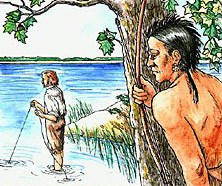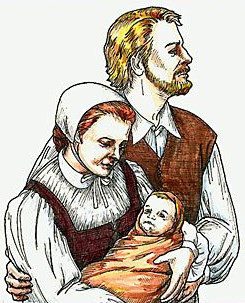|
Although Sir Walter Ralegh must have been disappointed when his first colony returned to England in 1586, he did not give up. Neither gold nor silver had been discovered, yet there had been some successes. In nearly a year based on Roanoke Island, only four of 108 men had died and a large area had been explored. Nevertheless, it was obvious that Roanoke Island, with no safe access to deep water, was not an adequate site for a major settlement. Chesapeake Bay, not far to the north, was to be the site of the second colony.
The 1587 colony included women and children. Colonists had either invested in the project or had outfitted themselves and their families. Their return was a grant of 500 acres of land and a voice in the government. On 7 January 1587 the "Cittie of Ralegh in Virginia" was incorporated. No copy of the articles of incorporation is known to exist, but other documents clearly indicate that the city was to be governed by Governor John White and twelve assistants. Although three vessels — the 120-tun Lyon, a flyboat, and a pinnace — sailed from Portsmouth on 26 April 1587, it was not until 8 May 1587 that the ships finally left England. From the beginning, it seems that there were problems between Governor White and Simon Fernandez, the pilot. Off the coast of Portugal, they lost the flyboat in a storm. On 16 July they sighted the mainland. According to White, Fernandez mistook the vicinity off Cape Fear for the island of Croatoan and almost wrecked the fleet. 
Vicki Wallace Finally, on 22 July they arrived off the Outer Banks. They planned to look in on Grenville's men, then sail north to Chesapeake Bay and establish the "Cittie of Ralegh." However, as Governor White and forty of his men got on the pinnace, Fernandez instructed his sailors not to bring back any of the colonists, only the Governor. White as Governor was in command on land, but Fernandez as Admiral of the fleet enjoyed the loyalty of the sailors and "de facto" command at sea; thus the latter prevailed even in direct opposition to White's wishes and Ralegh's instructions. Arriving on Roanoke Island, White and his men found the fort razed and the houses abandoned. Of the fifteen men left by Grenville, the only trace was the skeleton of one man. White immediately had his men fix up the village and repair the fort. But finally there was one bit of good luck — the flyboat, last seen off Portugal, arrived. Although two Indians — Towaye and Manteo, the latter to be made head of Wingina's domain — had returned with the English, no contact was made with the local Indians until, less than a week after the arrival of the English, George Howe was ambushed and killed while crabbing. Two days later Edward Stafford with Manteo and twenty colonists went to Croatoan, Manteo's home. 
Vicki Wallace Even Manteo's people were wary of the English for fear the white men would take their limited supplies of corn. The Croatoans explained to Stafford that Howe had been killed by some of Wingina's men, and soon White, Stafford, and two dozen men attacked the village of Dasamonquepeuc in retaliation. Surprising the village, they found not the Roanokes, but Manteo's people, the Croatoans, who had gone to gather the corn left by the Roanokes who had fled after killing Howe. Manteo blamed his own people who had not kept the English informed and helped to prevent further hostilities between the two groups. On 13 August 1587 the English showed their appreciation to Manteo by baptizing him and, by command of Sir Walter Ralegh, creating him Lord of Roanoke and of Dasamonquepeuc. Thus was the first Protestant baptism and the first granting of an English title in the New World. Five days later, on 18 August 1587, there was another joyous occasion. Elinor White Dare gave birth to a daughter, Virginia, the first child born of English parents in the New World. Later, Margery Harvey gave birth to a baby whose sex and name were not recorded. In the meantime, Simon Fernandez had lain offshore for a month while the colonists unloaded their supplies. As the time for his departure drew nearer it became obvious that a leader of the colony must return to England with Fernandez in order to obtain badly needed supplies. None of the assistants wanted to go, and on 22 August 1587 the entire colony went to Governor White and asked him to return to England. White was in a dilemma. He was needed both to ensure the timely delivery of supplies and to govern the colony. On 25 August the colonists put their request in writing and Governor White agreed to sail. Presumably, the seven assistants who remained on Roanoke Island were left in charge of the colony during White's absence. The Governor clearly understood that if the colonists should decide to leave the fort, they would carve their destination on a tree and add a Maltese cross if they had to leave because of attack. The return trip to England was disastrous. When the fleet arrived at the Azores only five of fifteen seamen with White aboard the flyboat were fit for duty. Fernandez, aboard the Lyon "meant not to make any haste for England," but planned to "linger about the Islande of Tercera" in hope of capturing a vessel or two. So the flyboat headed eastward alone. Because of bad weather, the vessel did not reach Ireland until mid-October. White left the flyboat and went on to England. White's misfortunes continued after his return. Philip II of Spain was amassing an Armada for an attack on England. Ralegh attempted to assemble a fleet of six small ships to send to Roanoke Island, but it became clear that White ought to return to the colony sooner than this fleet was likely to sail. Within four months White had the ships ready to sail, but because of the imminent Spanish attack they were not allowed to do so. Two of the smaller ships — the 30-tun bark Brave and the 25-tun pinnace Roe were deemed inadequate for defense purposes and White was allowed to have them. Following the usual practice, the ships engaged in piracy on the way. Unfortunately for White and the colonists, the Brave was attacked by larger French ships, lost the ensuing battle and limped back to England. Later, the Roe also returned. The mighty sea battle with the Spanish Armada was fatal to the attempts to relieve the colonists on Roanoke Island. A year and a half passed after the defeat of the Armada before ships were again sent to Roanoke Island. Finally on 15 August 1590, three years after his departure, White arrived at what we now call the Outer Banks. The next morning the English saw what they presumed to be signal fire from the colonists, but after a long walk down the beach they found no settlers. On 18 August 1590, Virginia Dare's birthday, the English finally arrived at the site of the village. They found carved on the palisade surrounding the fort the word "CROATOAN, without any crosses or signs of distress." Stormy weather and problems with the ships made it impossible to go to Croatoan, and White was unable to make contact with any of the colonists. There have been many theories about their fate, but none can be proved. Consequently, John White's colony will almost certainly remain the Lost Colony. Text by John D. Neville, Chairman, North Carolina 400th Anniversary Committee Illustrations: Vicki Wallace |
Last updated: April 14, 2015
